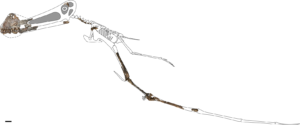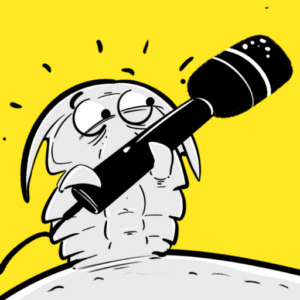This is a transcript of Episode 10: The Research Journal: Pterosaurs and Kangaroos.
Travis Holland 0:06
Welcome to fossils and fiction, a podcast exploring cultural and scientific ideas about dinosaurs.
I’m Travis Holland. In this episode of Fossils and Fiction, it’s the first in a new format that I’m calling the Research Journal. It features detailed discussion of two recent publications with two PhD candidates, Isaac Kerr from Flinders University joins me for a chat about his work on a new genus of kangaroo from the late Pleistocene of Papua New Guinea. And Adele Pentland from Swinburne University and the Australian Age of Dinosaurs Museum is here to discuss the osteology of Ferrodraco lentoni, an Anhanguerid pterosaur from mid Cretaceous Australia. Of course, neither the kangaroo nor the pterosaur are specifically dinosaurs. But so far as I’m concerned, big, dead and in the ground is just as good. Welcome.
Adele Pentland 1:28
My name is Adele Pentland, and I’m a PhD candidate at Swinburne University of Technology in Melbourne and honorary research associate at the Australian Age of Dinosaurs Natural History Museum
Travis Holland 1:41
Adele, I wanted to have a chat about your new paper, the osteology of Ferrodraco lentoni, which is one of the most well known or the most well known Australian pterosaurs. Tell us about what you found in this 2022 paper.
Adele Pentland 1:56
This more recent paper was an opportunity to try and describe as much of the skeleton in as much detail as possible. And then I also wanted to try and do a phylogenetic analysis, even though we did one previously in the 2019 paper, I wanted to contrast the results and use a different data matrix and see how that impacted the results.
Travis Holland 2:24
What did the new analysis show?
Unknown Speaker 2:26
So the position of Ferrodraco lentoni didn’t change that much. So it is still coming out as the sister taxon to Mythunga camara. So, Mythunga is the first pterosaur species that was named from Australia in 2007. And it’s a little bit older than Ferrodraco. So that kind of makes sense that you would have these two Australian taxa together. But then, this more recent analysis demonstrated that they are more closely related to two other Gondwanan pterosaurs. So Tropeognathus mesembrinus and Siroccopteryx moroccensis. So I should explain that Gondwana is that big supercontinent that included Australia as well as New Zealand, New Caledonia, Antarctica, India, Madagascar, and South America and Africa. So what these results are showing is that our two Australian taxa are closely related to one species from South America and one species from Africa, which sort of makes sense, we see this pattern in terms of the diversity of dinosaurs as well and other groups. But this does differ from the 2019 analysis, because in that paper I showed that Ferrodraco was closely related to Ornithocheirus simus, which is actually from England, but in this in the 2022. paper, Ornithocheirus simus is sort of popping out of the phylogenetic analysis very early on. So it’s sort of demonstrating that it’s more basal in this matrix, but that is probably because Ornithocheirus simus is just the very tip of the snout. So we sort of see this happen more generally, in not just the phylogenetic analysis of pterosaurs, but all kinds of things if you don’t have a lot of information, anatomical structure to describe, or if something is being misinterpreted, say, if you have interpreted what is actually a lizard as a small dinosaur, then it’ll pop out early in the phylogenetic analysis. So yeah, just some very different analyses. I’ll probably continue to rescore and add Ferrodraco into more phylogenetic analysis in the future and just try and refine it
Adele Pentland 3:39
We should have just a little bit more background on Ferrodraco. As I understand the name means iron lizard. Is that correct?
Iron dragon.
Travis Holland 5:13
Iron dragon? Yeah, of course Draco.
Unknown Speaker 5:16
No, I had the privilege of naming the one. Yeah, it was me. Yeah, we had picked a nickname for the individual. So that was nickname Butch after Butch Lenton, who was the previous mayor of Winton. Winton being the town near where Ferrodraco was found. I wanted to name the species off to Butch Lenton. So that’s why it’s Lentoni. And I. And yeah, I wanted to have a name that was easy for kids to say. So I had a bunch of like, different combinations of words in an Excel spreadsheet. And then I came up with Ferrodraco. And then later found out it’s like a boss in Minecraft, which I had no idea about, because I’m too old for Minecraft.
Travis Holland 6:01
Can you explain the scanning process that underwent – that the fossils underwent at the synchrotron
Unknown Speaker 6:07
We took the specimen down to the synchrotron near Monash and close to Melbourne, if you’re not familiar with this part of Australia, and the synchrotron is a big round building, and it’s a particle accelerator. So it’s shaped like a doughnut because it means to accelerate particles, and then those are projected at whatever object you’re studying. So at the time that I took Ferrodraco down for scans, they were also studying clay tablets, archaeological artifacts. Yeah, it could be used for all sorts of things, it has medical applications. So a cool upshot of that is that we can use it to study the internal structure of fossil material of bones. Unfortunately, a weird thing happened when we had the synchrotron scans done. So the shape of the teeth of Ferrodraco are just the perfect size, that they actually focused the laser beam that was being projected at it, and it scratched the sensor, which was really bizarre. And I thought, in a bit of a panic when Dr. Joseph Bevitt, who’s a co author on the paper, when he told me that happen, you know, it was gonna hold the process up for hours, which cost 1000s of dollars. But, yeah, it was just like a little scratch on the sensor. Just yeah, the process of getting anything scanned at the synchrotron like it’s pretty competitive process because the high resolution. And yeah, it’s, it’s a big, the big drama when you damage the sensor or something needs to, to be replaced or fixed with that, as I understand it.
Adele Pentland 6:07
In the collusion, you mentioned that there are some indications of diversity of pterosaurs even though you’ve only really got a handful at the moment.
Palaeontologists sometimes get made fun of because the conclusion of basically every paper is we need more fossils, to study and sort of get a better picture of things. But, you know, as we sort of demonstrated with this specimen, you know, the discovery of one fossil can really change and shed light on our understanding of these ancient ecosystems. So the hope is that if we find more examples, then we can possibly see how there might be individual variation or get a better understanding to see is there more than one species of pterosaur present in this particular geologic formation? And then we’re looking at stuff you know, that’s 10s of millions of views apart, or a few million years apart, can we can we possibly prove that one species is directly evolving into the other? but that’s normally very difficult to demonstrate.
Travis Holland 9:28
Isaac, tell me about your paper, ‘A new genus of kangaroo from the late Pleistocene of Papua New Guinea.’
Isaac Kerr 9:36
Yes, so what we’ve essentially done is we’ve had a look during my PhD which is on the systematics and paleo biology of an extinct genus of kangaroo called Protemnodon. We re examined the identity of some fossils that were found in the 70s in New Guinea, from a place called Nombe Rock Shelter. And the species was called Protemnodon nombe by Tim Flannery in his study in the early 80s, we had a good look at that set of fossils and compare them to the rest of pretended on. And basically, they weren’t fitting they had quite different teeth. And you know, when you’ve just got sort of two jaws to go off, which is what we had for this species, you know, the teeth are very important. So we saw, okay, this isn’t a Protemnodon, you know, so what is it and we looked at every other kangaroo that we could find, and you know, it wasn’t really fitting with any of those either. And so I thought, this is pretty interesting. And had these features of the jaw that sort of showed, you know, sort of quite a muscular jaw and had features that showed it was maybe related to more basal kangaroos to, you know, something that evolved a little earlier an older lineage, we might say, and yeah, so we popped it in, in its own new genus, which we creatively also called Nombe. And yeah, put it in an evolutionary phylogenetic analysis and basically found that while obviously, just with two jaws, you know, that’s not heaps tick off. It seems to suggest that Nombe nombe was quite a basal kangaroo and early lineage of kangaroo.
Travis Holland 11:19
It shows really how science works sometimes, even someone like Tim Flannery, you know, he produces this work, which obviously stands for a while, and then somebody new comes along and does a bit of reinterpretation. I think that’s really important to understand for people how science, you know, is a process of testing and retesting these ideas.
Isaac Kerr 11:38
Yeah, absolutely. You know, and I’m Tim, sort of, he’s followed, you know, all of these, like strands of research and done all this amazing work over the years. And you can sort of see why he couldn’t come back to work on little Nombi nombe. But it’s been nice, because he was actually the one of the reviewers on the paper. So sort of, you know, got to have his thoughts and his input, as we were sort of addressing some of his early work.
Travis Holland 12:08
Did you get to come up with the name?
Isaac Kerr 12:12
Yeah, so um, that was basically, you know, a couple of months of sort of bouncing around in the back of heads, you know, had lots of different ideas, sort of names, I guess, talk about like, the funny curve, and the crest of its teeth and things like that, or maybe it’s kind of robustness. But there are all sorts of features that, you know, we’re not sure, they’ll necessarily define the genus. You know, should we find other species, for example, or, you know, would be such an important feature of the whole of the kangaroo as a whole if you know, what I mean, when we’re just talking about teeth and jaws. So basically, there wasn’t a lot to go off of the name, you know, for naming it. And we thought that Nombe nombe, you know, memorable has a ring to it. Very simple. You know, just went with that. Yeah, I suggested it to Gav, you know, thinking he’d say it was silly, and he said it was good. So Gav is my supervisor.
Travis Holland 13:09
And co author on the paper.
Isaac Kerr 13:13
That’s right. Yeah.
Travis Holland 13:15
Brilliant. That’s, that’s, that’s fantastic. Really interesting. What implications do you think this has for the way we understand kangaroo evolution across the continent?
Unknown Speaker 13:24
I mean, it’s a it’s a fairly small paper. So I’d say the implications are maybe gentle. But yeah, essentially, it’s it’s suggests that, particularly in New Guinea, where this is from suggests that the macropodae there, the kangaroos from there are a bit more diverse than we thought for a while there was sort of the question, Why, I should say the megafauna or the marsupial megafauna array in New Guinea is it’s quite sparse compared to Australia. So we have just the diprotodontids, the giant quadrupedal herbivores, just a few species from there, I think. And then from the Pliocene and Pleistocene, the kangaroos we have, I think, off top my head, maybe six species. And then there’s thylacines. And I think that’s it for what we might consider giant marsupial. So that’s three marsupial families. And then in Australia, I think this just in the Pleistocene was at least eight. And as we discussed, they weren’t connected, you know, for quite a period of time. And so why that is, isn’t really apparent, why there are so few megafauna marsupials in New Guinea. But this basically suggests that there were, you know, there was this greater level of diversity and that there were sort of possibly multiple movements of megafaunal marsupials into New Guinea rather than just sort of one, you know, early In the Pliocene, there might have been more significant, more significant ones earlier. And it also just basically shows that, um, you know, we don’t know everything about, you know, what what kangaroos are and what they were well into when you know, humans were in Australia.
Travis Holland 13:26
Fantastic. Is there anything else we need to know about Nombe nombe?
Unknown Speaker 14:03
Ah, not yet. Just watch the space. Hopefully, you know, we’re going back into New Guinea. Very exciting, starting in the middle of next year. And then again, for two more trips, two consecutive years. Yeah, hopefully we find a you know, more bones, maybe even a complete skeleton, and we get to tell everyone what it actually looks like. You know, we’ve we’ve had a pleasant amount of media interest in this stuff, you know, friends I haven’t seen for a very long time saying, Oh, I read your article, whatever. That’s been very nice. So yeah, hopefully we get to show you what it looks like in a couple years time.
Travis Holland 16:03
Fantastic. We will link both the full published article and also your Conversation piece in the show notes as well. So anyone who wants to follow up can find out more information. Isaac Kerr, thank you very much for joining Fossils and Fiction.
Thanks to Adele and Isaac for taking the time to tell us about their work. It’s fantastic to see such interesting and exciting work emerging from young Australian scientists. Full details of the papers we discussed will be in the show notes. Thank you for listening to the Fossils and Fiction podcast produced by me Travis Holland with the support of Charles Sturt University. The podcast theme music is Sonora by Quiincas Moreia via the YouTube Audio Library. Find more content on our social media channels, Twitter, Facebook, YouTube, Instagram, and Tiktok. Show notes are available on the website fossilsfiction.co. You can subscribe to the podcast on all major podcasting platforms.


